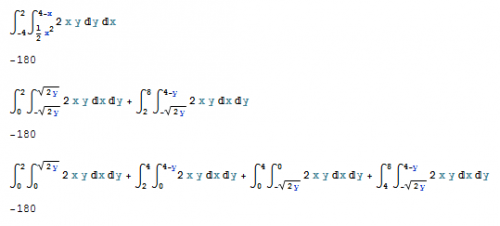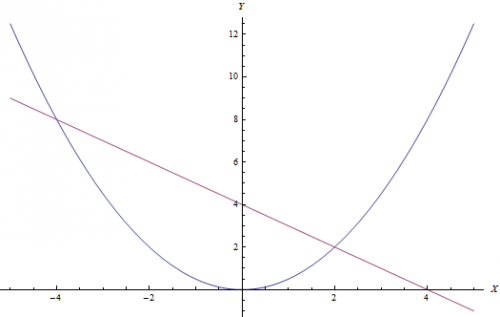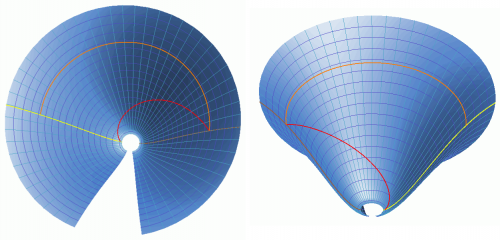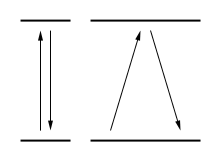-
Posts
719 -
Joined
-
Last visited
-
Days Won
2
Content Type
Profiles
Forums
Events
Everything posted by Daedalus
-
LOL... The new look isn't that bad ; ) Furthermore, it seems that the forum is working correctly with IE. I can actually view my profile and check my messages without having to jump through hurdles. Before the upgrade, the drop down menu would instantly go to my profile page whenever I clicked it. Now I can actually choose one of the menu items.
-
The concert was awesome, and I had a great time!!! I went back to my house and grabbed my PC because I am staying with my brother this week. Once I have it set up, I will be able to help you. Just by looking at your latest post, I'm wondering if the bounds along the [math]y[/math] axis is correct. I'm not sure how you arrived at [math][0, \, 3x][/math]. Although I will have my computer set up later tonight, perhaps someone else can help you if time is of the essence.
-
Although areas and volumes are generally positive values, integrals represent a lot more than just geometrical entities. For instance, if you have the derivative of a function, then you can integrate the derivative and obtain the original function. Of course you will need an initial value in order to solve for the constant of integration, but the point is that the original function (which is the integral of the derivative) may very well have negative and / or positive values. So you see, it is entirely possible for integrals to generate negative values, and in some cases the integral may be undefined pending the interval and function being integrated. As for the next integral you are having problems with, I will try and make a post later tonight once I get back from a concert I am attending. My friends are playing tonight and I get to go backstage and hang out with them and the other bands.
-
Perhaps an angle can be considered a ratio in certain space. However, slope can be obtained by taking the tangent of an angle. For instance, [math]\text{tan} \left(\pi / 4\right)=1[/math], which demonstrates that trigonometric functions are ratios while angles are measurements.
-
Numbers are just numbers until we give them meaning. So it is not proper to think of any number as a ratio. However, a ratio can have any numerical value : ) Furthermore, angles are not ratios. The trigonometric operations applied to angles are ratios. For instance, the sin of an angle is the height divided by the hypotenuse, but the angle itself is just a measurement.
-
Hi Prometheus! Sorry I haven't responded. I have been busy all day and just now got home. As for the double integral, you have everything written correctly and should have arrived at -180 for the answer. I use Mathematica and worked the problem three different ways. And yes, your lower bound will always be less than the upper bound except in some special cases. Just remember that if you reverse the bounds on a single integral you basically switch the sign of the result. However, this isn't always the case with a double / triple integral because you have to consider higher dimensions than just two. For instance, this particular problem has a negative answer because the function [math]z=2xy[/math] falls into the negative [math]z[/math] range for most of the bounding region. Besides arriving at the wrong answer, I must congratulate you for actually setting up the integral correctly. Just be careful when constructing your bounds, and I highly recommend getting a TI-89 because you can check your answers and it will graph in both 2D and 3D.
-
Another interesting fact is that the diagonal rows are increasing summations of [math]y=x[/math] or just [math]y=1[/math] if you consider the outside 1s: ) Furthermore, pascal's triangle shows up in many equations and algorithms ranging from simple algebra to finite calculus. This can be seen in the following formulas from my fourth challenge:
-
The proper term you are looking for is dimensionless units or dimensionless quantity. The measurement representing the angle still has units, which can be in degrees, radians, or whatever you want to call it. Hi Arnaud Antoine ANDRIEU. I just wanted to point out that there are [math]2\pi[/math] radians per [math]360[/math] degrees or 1 revolution. As for the rest, I have no idea what you are talking about.
-
You're welcome! I always graph the bounding region regardless my confidence in picking the correct functions for my bounds, and it is a good habit to do so. You are correct about the limits for the outer integral not being right. The limits of integration along the [math]x[/math] axis are opposite from what you just posted. The lower bound is -4 because it is less than 2. You should have: [math]\int_{-4}^{2} \int_{\frac{1}{2}x^2}^{4-x} 2xy \ dy \, dx[/math] Now for the split integral. The limits of integration for the [math]y[/math] axis in the first integral is correct, but the lower bound for [math]x[/math] axis is incorrect. Refer to my hint about radicals in my first post and look at the graph I posted ; ) The limits of integration for the [math]y[/math] axis in the second integral is also correct, but the lower and upper bounds for the [math]x[/math] axis is wrong. Again, refer to my hint about radicals and look at the graph to see if you can spot the mistake.
-
The illusions in this video are pretty cool.
-
Hi Prometheus. I checked the integral and arrived at the correct answer for both, [math]x[/math] and [math]y[/math], axes. The problems you are having is that you do not have the limits of integration arranged properly when first integrating along the [math]y[/math] axis, and you have the wrong limits for both *edit* integrals when first integrating along the [math]x[/math] axis (the [math]y[/math] limits are good). I suspect that you have a graphing calculator that will at least graph multiple functions in two dimensions. I suggest that you simultaneously graph [math](1/2) x^2[/math] and [math]4-x[/math]. Graphing the bounding region will help you identify the lower and upper bounds for the double integral. The key is that the function used for the lower bound will be less than the other function along the axis of integration. Oh... one more thing to note. Do not forget to add a negative sign to [math]\sqrt{2 y}[/math] when dealing with negative values of [math]x[/math]!!! After all, [math]x = \sqrt{2 y}[/math], which has two solutions for values of [math]y > 0[/math].
-
Hi Tinku. Myself as well as many others here at SFN can help you with your quest. I am a software engineer by trade with over 10 years of professional engineering experience. I suggest learning C++ and / or C# so that you can work with a graphics API such as DirectX or one of the high level APIs like Ogre or XNA in order to bring your models to life with 3D rendering. I mainly program cross-platform engines, but I recommend that you start with Windows or Linux and read the API documentation and study several source code examples. You can simply google "C++ DirectX Tutorial" and find a wealth of knowledge that can help get you started. I've also responded to your PM and am willing to provide guidance through our private and public conversations. You can also download the programming tools for free on the internet. C++ / C# express can be obtained from Microsoft and gcc with KDevelop can be obtained on a Linux platform. As for Matlab or Mathematica, you can use them to model the math. However, nothing beats custom programming for the application you wish to develop.
-
What's going on here is two different data sets. One rules out linear coasting cosmology, and the other strongly supports it. My questions, "What about the case where space is expanding at a constant rate but the galaxies are in motion relative to their local space? Wouldn't that also produce an apparent acceleration in the expansion of space?", would resolve such discrepancies. If space is expanding at a constant rate, then it would produce the linear coasting cosmology [math]\alpha = 1[/math]. Without including gravity we can show that we would still observe an apparent acceleration in the expansion of space. However, we can assume that there is more matter outside a radius surrounding our super cluster, than within it. Double that radius and it's possible that there could be even more matter outside this new radius, and so forth. If these things are gravitationally interacting, then the net force acting up inner rings would increase such acceleration allowing for an observed [math]\alpha > 1[/math] while maintaining the constraints imposed by the H(z) data.
-
I'm actually wondering what Iggy's reply is to the post (#210) I recently made. "Although your references support a cosmological / particle horizon, as of 2008, they were not able to rule out an open linear coasting model as supported by the H(z) data. However, one does have to note that power law cosmology is still outside the currently favored ΛCDM model." and "What about the case where space is expanding at a constant rate but the galaxies are in motion relative to their local space? Wouldn't that also produce an apparent acceleration in the expansion of space?"
-
It's a freely coasting universe. One where gravity (attractive from matter or repulsive from dark energy) doesn't affect expansion. I did a search and it is correct that such a universe doesn't have an event horizon: It's pretty far from mainstream. Iggy, that is definitely an interesting paper. I researched the authors who wrote the paper and found that Daksh Lohiya was a common factor in a series of papers written about a linear coasting cosmology. A list of publications by Daksh Lohiya and his colleagues can be found here: http://en.scientific...rg/daksh_lohiya In Daksh Lohiya's paper, "Power law cosmology - a viable alternative", published in 2008, the authors summarize the following: Although your references support a cosmological / particle horizon, as of 2008, they were not able to rule out an open linear coasting model as supported by the H(z) data. However, one does have to note that power law cosmology is still outside the currently favored ΛCDM model. What about the case where space is expanding at a constant rate but the galaxies are in motion relative to their local space? Wouldn't that also produce an apparent acceleration in the expansion of space?
-
Yeah I like it too. I got that quote from one of my engineering buddies when I worked at Casino Systems Inc. programming slot machines.
-
No I did not include the acceleration of the expansion of space, which might make it impossible for photons to reach us. However, that is just one interpretation to what accelerated expansion is. If we consider the universe as shaped as a sphere, then the ant on a rope problem still applies to moving across the sphere as it expands. This would result in space expanding at a constant rate, while gravitational bodies are pulling on each other across the sphere (this could apply to a flat universe too). This should impart different velocities onto galaxies which can be interpreted much like the ant moving away from us such that a galaxy would have a velocity [math]v_a[/math] with respect to the expansion of space. This will make the galaxy appear to be accelerating away from us while photons that are emitted would only be subjected to the constant expansion of space, and hence could reach us. However, that is just combining certain views on the subject and is not what mainstream science supports, which would mean that such an event horizon as you speak of is possible. I just wanted to use some simple calculus to demonstrate the vast amount of time it would take for the ant to reach the end of the rope : )
-
I have been wanting to make a post in this thread regarding the ant on a rubber rope problem, but I have been extremely busy and have just now found the time. Actually, if the road is expanding in accordance to the expansion defined in the "ant on a rubber rope" problem, you will eventually reach your wife. However, you may be dead before you get there due to the amount of time it takes to complete the journey. "Two views of an isometric embedding of part of the visible universe over most of its history, showing how a light ray (red line) can travel an effective distance of 28 billion light years (orange line) in just 13 billion years of cosmological time. Click the images to zoom. (Wikipedia)" Now lets move on to the required mathematics for what is being discussed here in order to demonstrate that, according to expanding space equivalent to the "ant on a rubber rope" expansion, photons that are emitted after the recessional speed exceeds [math]c[/math] can reach us given enough time. However, this makes no guarantee that the galaxy emitting the photons would actually still be emitting photons, or that the photons will not have redshifted to an undetectable frequency. One can however use the mathematics to show that the distance is traversable. The ant on a rubber rope Wikipedia actually provides a decent description of problem. I modified the variable names used in Wikipedia to make the problem easier to read. According to the definition for the problem, the equation for position of the ant on a rubber rope is a first order linear differential equation: We can solve this nonhomogeneous linear differential equation using Integrating Factors. We begin by rewriting the differential equation in the form: [math]\frac{dx}{dt} = \alpha (t) \, x + \beta (t)[/math] where [math]\alpha (t) = \frac{v_r}{v_r \, t + x_1}[/math] [math]\beta (t) = v_a[/math] and the integrating factor is [math]\mu (t) \, = \, e^{\left(-\int_{} \alpha (t) \, dt\right)} \, = \, \frac{1}{v_r \, t + x_1}[/math] After working the method, we arrive at: [math]x(t) \ = \ \frac{1}{\mu (t)} \int_{} \, \beta (t) \mu (t) \, dt \ = \ \left(v_r \, t + x_1\right) \left(\frac{v_a}{v_r} \, \text{ln} \left(v_r \, t + x_1\right)+C\right)[/math] Now we have to find the value for [math]C[/math] that satisfies our initial condition [math]x(0) = 0[/math]: [math]x(0) \ = \ x_1 \left(\frac{v_a}{v_r} \, \text{ln} \left(x_1\right)\right)+x_1 \, C \ = \ 0[/math] [math]x_1 \, C \ = \ - x_1 \left(\frac{v_a}{v_r} \, \text{ln} \left(x_1\right)\right)[/math] [math]C \ = \ -\frac{v_a}{v_r} \, \text{ln} \left(x_1\right)[/math] After substituting [math]C[/math] back into our general solution and simplifying the result, we arrive at the following equation for the position of the ant at time [math]t[/math]: [math]x(t) \ = \ \left(v_r \, t + x_1\right) \frac{v_a}{v_r} \, \text{ln} \left(\frac{v_r \, t \, + \, x_1}{x_1}\right)[/math] However, it is extremely difficult using the above equation to determine the value of [math]t[/math] that will tell us how much time it took the ant to complete the journey. If you read the ant on a rubber rope problem in Wikipedia, they offer a different method that will allow us to solve for [math]t[/math]. Just for fun, if we substitute the above equation for the total time into our function [math]x(t)[/math] for the position of the ant, we can determine the total distance traveled by the ant. [math]d = x\left(\frac{x_1}{v_r} \left(e^{v_r / v_a}-1\right)\right) = x_1 \, e^{v_r / v_a}[/math] [math]\therefore d = (1\, \text{km})\, e^{100000} \approx 2.8 \times 10^{43429} \, \text{km}[/math] Now that we have shown that the distance is traversable in a finite amount of time, we can argue that photons or anything else can reach us from any point in space. However, we would have to use the above equation to calculate the total amount of time it would take for the journey. If we get a time estimate close to that of the ant, then we can be fairly sure that the probability of a photon reaching us is practically nonexistent (much less for anything else) because the Earth will not be around that long and there is a good chance that neither will we : ) In another light, the math does suggests that it is possible for photons to reach us from galaxies that are receding away from Earth at speeds greater than or equal to [math]c[/math]. Whether or not we can detect them is a different matter altogether.
-
The point of the paragraph you quoted is to demonstrate the general workings of a clock. It does not in any way attempt to describe QM effects. Sure, you can attempt to bring QM into the discussion. However, you cannot truly be certain whether these oscillations, as you say, are not as physical. A counter-example to your argument can be seen in string theory. You even state that "time doesn't oscillate any more then the dimension of width oscillates". However, you failed to recognize that units of width do oscillate in their own way. I can create a wheel that marks out one meter per cycle of the wheel. Thus each unit of width that I measure represents a cycle. I can add up the number of cycles the wheel has made and arrive at a measurement of width. So, unless you have a working theory of everything and can be so bold as to rule out physical motion at the quantum level, let's keep QM out of the discussion. Here you are compounding this notion of time with how you currently understand it. There is no change in position of time over time. That makes no sense at all. However, you have to ask yourself a more fundamental question to the nature of time. One that brings into question whether or not measurements of time are needed at all in order to describe a physical system. The answer to the question is that time, as is currently measured, is not needed because we can use motion instead. If I have a light clock, I can either count the number of round trips (cycles) the pulse of light has made or I can measure the distance the pulse of light has traversed each cycle. Either way, both measurements can be used to quantify motion. One method quantifies motion to the count of cycles a clock makes and the other quantifies motion to the distance traversed by the oscillating mechanism the clock uses. You may argue that QM doesn't operate in such a classically defined way. However, much like in GR, if you cannot tell the difference between being in a room that is accelerated versus one that is in a gravitational field, then how can you tell the difference between clocks that use classically defined motion versus the few that are based on principles of QM. Both types of clocks simply count the cycles of their oscillating mechanism. The difference is that if you base time on the cycles of the oscillating mechanism, then you must account for the time dilation of clocks in relative motion to each other. However, if you base time on the distance traversed by such mechanism, then time dilation is automatically included. This is evident in that the path of the oscillating mechanism for the clock in motion relative to the observer is elongated such that the clock in relative motion will appear to run slower than the observer's clock. This is demonstrated in the following image where the observer's clock is to the left and the clock in motion relative to the observer is to the right. As you can see, the path of the oscillating mechanism for the clock that is in relative motion to the observer is elongated. The point is that if we can use motion instead of counting cycles to define equations that describe the motion of an object, then time itself must be based on motion. The result is that the differences between the temporal and spatial dimensions can be resolved within the framework of relativity by using nothing more than motion itself. In order to understand the full implications of the theory, you must read beyond the first post in the thread. I have provided a framework that resolves the differences between the temporal and spatial dimensions. Of course, there is plenty of speculation on my part. The mathematical model I provided is missing several key elements. However, I do support my argument throughout the thread and continue to develop the model. I have even created a new model since my last posting that takes into account motion across expanding space. You are at liberty to disagree with me, and I do encourage criticism. The only thing I ask is to be thorough in your objections, which requires understanding the model itself.
-
As many of you are aware, I post challenges in the Brain Teasers and Puzzles forum in order to help others expand upon their mathematical abilities. I actually have developed these challenges myself (except for the cow, a rope, and a round barn challenge) without looking them up in books or on the internet. I have been doing this since 1994 and have gotten pretty good at modeling - deriving mathematical equations that predict the behavior of a system. I have learned how to recognize patterns that allow me to reduce problems (series of numbers) into manageable equations that are put together much like pieces in a puzzle. Thus, mathematical modeling is the most extreme form of puzzle solving because instead of putting jigsaw pieces together to arrive at the big picture, you are using mathematical patterns (equations) to do the same. This is different from most people's experience in math class where they are asked to input numbers into predefined equations to obtain a numerical result or solve for some unknown value of [math]x[/math]. With modeling, you actually derive your own equations. I believe modeling / pattern recognition needs to be taught because it teaches you how to be a true mathematician. Therefore, I've decided to create this poll to see how many of you are interested in learning how to model your own mathematical systems. If enough people are interested, I will create a tutorial regarding this subject. We will start by exploring simple patterns that are universal to most every system, and work our way towards modeling complex systems. You do not have to be a math expert to benefit from this because you will be learning how to recognize patterns in numbers. All you need is the desire to learn math, but it also helps if you like / love solving puzzles. To show you the type of systems that can be solved, the following are links to my challenges and a tutorial I produced for SFN: Daedalus' First Challenge Daedalus' Second Challenge Daedalus' Third Challenge Daedalus' Fourth Challenge Daedalus' Fifth Challenge and Tutorial on Finding the Maximum and Minimum Values of a Function
-
I thought pentropy was this:
-
Fall session officially starts today. I aced spring and summer sessions, and I am looking forward to acing this semester. Wish me luck!!!
- Show previous comments 1 more
-

Thanks Phi for All. I appreciate your vote of confidence : ) Everything is going good. Hopefully, I will also get to work for the math lab as a tutor. The manager told me to apply as soon as the job posted.
-

Well I will wish you good luck even if Scrouge McPhi says it isn't necessary. And one day I will be able to complete one of your mathematical challenges
-

Imatfaal, I am actually considering a series of tutorials that explains step by step on how I arrive at the mathematics for my challenges. I was lucky enough to have a teacher in the 9th grade that kept me after class and showed me that I could actaully do mathematics. I took the initiative and began to solve problems that I invented myself (Granted most problems were already known). However, I worked towards solutions to these problems as if they were never known (not using any help except a...






